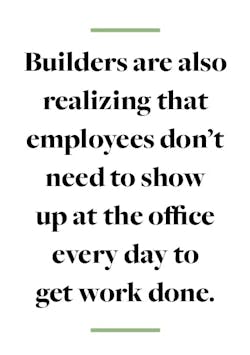Building Relationships on Screen
Custom home builders often say they don’t just build dream homes, they build relationships. Some of these connections last long after move-in, with clients inviting their builders to holiday parties in their new homes and even to their children’s weddings. Those roots are established during the first builder-client meetings, when prospective clients audition builder candidates for attributes such as reputation, portfolio, construction quality, team, and transparency. The face-to-face meeting is the coveted moment when a builder can rain attention on the prospect and show how his or her process will meet client expectations and produce a product that will improve the client’s quality of life.
But what happens when the coronavirus and shelter-in-place orders eliminate that opportunity to meet in person? Can the magic happen over Webex, GoToMeeting, or Zoom? As one builder put it, “We used virtual tools before, but now we really use them.” Forced by the pandemic to rely more on digital technology for communication, some builders are reevaluating how they operate in-house with employees and how they progress through project phases with buyers.
On-screen Meeting Culture
When Pennsylvania’s shelter-in-place mandates shut down construction during the first week of March, Chris Bergh, partner and director of construction for Pohlig Custom Homes, in Malvern, Pa., met with his information technology guy to learn what tools were at his disposal. “Virtual tools were a borderline foreign topic for us,” Bergh says, even though the company already had Microsoft Teams, UberConference, Zoom, and GoToMeeting in its digital toolbox; they weren’t really being used. “For us, work was at the office. If we had a meeting, everyone was in our conference room or on site, and we leaned on our vendors to operate out of their showrooms,” he says.
Despite this, Bergh describes the transition to shared screens as almost seamless. He held weekly meetings with the superintendent, project manager, and selections coordinator while they were each working from their homes. “That meeting alone was one of the most powerful things we’d put in place in years because you’re checking in on a weekly basis and all three of you are holding each other accountable,” Bergh says. “And it’s not like we didn’t have those things in place before, but with this digital platform, it was almost an intimate setting. The meeting started on time, we cut out the chitchat, and for me it was nice to see the faces of my employees while I’m stuck at home. You got a glimpse into one another’s personal lives, with wives and kids walking around, and we had very impactful, meaningful discussions.”
Clients would be looped in when appropriate, and all of Pohlig Custom Homes’ vendors were able, on some level, to host selection meetings online. Selections seemed to go quicker and more smoothly with buyers who were building their second homes, according to Bergh, because they were more familiar with the process and products compared with clients building their first custom home who needed to touch and see selection items.
During the early days of the pandemic, Andrew Black, partner at Alair Homes, in Forest Hills, Toronto, felt some anxiety about maintaining client relations and communicating with his team without in-person meetings. But after a month of virtual meetings, he shared during a recent conference call with fellow Alair franchisees that his operation was more efficient and productive than expected because employees are using time more efficiently. The virtual milieu added potency to action items, such as keeping tabs on what’s being executed and what’s coming next, so there is less need for traveling to the jobsite to do those tasks.
Before the pandemic, Alair Homes Charlotte was contemplating scouting for bigger office space. But partner Roger Ketchum says that after seeing his team keep projects progressing while working remotely, he’s reconsidered whether his franchise needs a bigger office and could actually move to a smaller building.
J. Sven Gustafson, president and CEO of Stonewood, a custom home building company in Wayzata, Minn., has observations about why plan markups, redlining, and selections seem to move along better than expected during his company’s virtual meetings. Stonewood has been using project management software for years and even developed a proprietary web-based construction management platform for custom home and small builders called BuildTools, which was acquired by ECi Software Solutions in May. So Gustafson’s employees are accustomed to accessing project information from their phones. Still, Stonewood had the custom home builder mentality of pushing for face-to-face sessions with clients. The builder would even urge out-of-state clients to get together every couple of weeks when they had time to travel to Minnesota.
“We would really push for those in-person meetings,” he says, “just because of the tangible benefits of being able to touch, feel, and see things. It felt like it was extremely important. Before the pandemic, that would [result in us] meeting less often and it would delay things, and I think the process became harder.”
But face-to-face sessions weren’t an option when Gustafson started working with Florida clients in late March. So his team and an architect would mark up and review house designs once a week through shared computer screens. By early May, Gustafson still had yet to meet his clients in person, but even so, the experience was working well because presenting via virtual meetings had streamlined the content, and meeting participants were very focused on what was on the screen.
“[With online meetings,] people are a little more careful with their time because you’re staring at a screen and you don’t want to chitchat,” Gustafson says. “You get down to business, get it done, and then you’re on to the next thing. In fact, it seems like things move along faster, and we get a lot done. Having the technology right there to quickly pull up photographs and plans, cut and paste ... you work online the way we work behind the scenes a little bit, but with the client as a part of it. So it’s just another form of being productive.”
Another benefit is that online meetings are recorded. So, rather than designating someone to take notes and write a memo later, documents and plans are marked up and annotated in real time during the meeting, saved as a PDF file, and distributed instantly to meeting participants. Previously, notes were written by hand, and that, along with other documents and drawings, would have to be scanned before being sent.
The video recording also establishes a record of what was and was not said and agreed to during those sessions. “Before we did these recordings, it used to be that you’d have those conversations with clients when they say, ‘But we talked about this,’ and you’re thinking, ‘Well great, but during what meeting?’ All that’s recorded now. Also, now when we bring new team members into the conversation at some point later in the game, they can look back at design meetings and budget review and virtually be a part of those [earlier] meetings and know everything that was talked about,” Gustafson says.
Changing the Sales Pitch
Cindy Kogelschatz, co-owner with her husband, Rich, of Heartland Builders, in Grand Rapids, Mich., says she had met virtually with out-of-state buyers numerous times before the pandemic. But she never participated in a virtual sales meeting with prospects shopping for a builder before Michigan’s shelter-in-place order went into effect in March. Before the pandemic’s new normal, prospects would meet Cindy and Rich at Heartland’s design center and would “automatically be wowed by the beautiful kitchen and looking at all of the other features they can get,” Cindy says. “But when your starting point is online, you don’t have that.”
So she reorganized the presentation. Rather than ending with a description of the building process, as she previously would have done during face-to-face meetings, she now starts with the process, explaining each step, from gleaning clients’ preferences and wants via a questionnaire, to the 3D design phase, to pricing, to land evaluation, selections, and so on.
“I start with that because it feels better. It works better for me and it puts clients at ease,” Kogelschatz says. “Online, we do cover the same sales topics, but there’s less chitchat. However, virtual meetings haven’t cut down on the time as much as I thought they would.”
When the world reaches the other side of this pandemic and the requirements of social distancing, Heartland will return to meeting clients in person as its primary selling tactic. “In custom building, most of our clients select us because they like us,” Gustafson says. “We also have a very nice product, but it’s the experience and the personal connection that they respond to. It’s awfully hard to do that virtually.”
But as for working internally, Gustafson says fellow builders in his Builder 20 Club, some who are also BuildTools users, are realizing that they don’t need their employees to show up at the office every day to get work done. “I wonder if builder offices and their setups are going to change over time,” Gustafson says. “I don’t know if we need to go back to having everybody in our office all day every day.”
Bergh is considering how the experience of working away from the office during shelter-in-place could create a permanent shift: “With Millennials coming into the workforce, the hot question is always, ‘Can I work from home?’” he says. “And we had a knee-jerk response: ‘No. Work is at work.’ But I think this [pandemic] experience is going to challenge that mentality a bit.”

